Sex Crimes, Pulp Heroes and Dreams of Flying – A Report from Interzone by Adam X. Smith
Featuring…
Sex Criminals Volume 1: One Weird Trick (Image, $9.99)
Moon Knight #1 & #2 (Marvel, $3.99)
Iron Fist: The Living Weapon #1 (Marvel, $ 3.99)
Captain Marvel #1 & #2 (Marvel, $3.99)
Serenity: Leaves on the Wind #3 (Dark Horse, $3.50)
Buffy Season 10 #1 (Dark Horse, $3.50)
Dredd: Underbelly One-Shot (IDW/Rebellion, $3.99)
Lazarus #8 (Image, $2.99)
Superior Spider-Man #31 (Marvel, $5.99)
So yeah. It’s been a few weeks since I checked in. I apologise to our loyal readers and my colleagues for my lack of diligence – it’s not like I’ve not been reading comics these past few weeks, I’ve just not been able to turn them into reviews worthy of your time. In my defence, I’ve been working hard on my final performance pieces for university – one of which involves me doing literally thousands of words worth of transcribing library books in one sitting – so I feel like I’m justified in taking a brief break.
However, at this juncture there are a few things that I’ve been itching to cover for a while, and rather than a bunch of straight reviews I’d like, if I may, to get a little bit stream-of-consciousness, free-and-easy, off-the-cuff and otherwise freestyle with you, gentle reader. At best, it’ll be a good go-to guide for what’s been cooking over at Radio X Lincoln and what’s worth hopping on board. At worst, it’ll be like taking a stroll into my fevered brain. Or possibly my Tumblr page. So…
Sex Criminals is a bit of a favourite on the Column – our estimable editor Jeb highlighted it as a “favorite new comic series for 2013”, and  with the release of the first volume in paperback, I’m here to tell you that you most certainly can take that to the bank. Aptly subtitled “One Weird Trick” and from the minds of Hawkeye and Immortal Iron Fist scribe and luckiest man in the world Matt Fraction and Canadian artist Chip Zdarsky, Sex Criminals follows Suzie and Jon, two people who are able to freeze time when they orgasm, a skill they use to rob banks in order to save Suzie’s local library from being foreclosed by a bank at which Jon is a disgruntled employee (and that, folks, is putting it mildly).
with the release of the first volume in paperback, I’m here to tell you that you most certainly can take that to the bank. Aptly subtitled “One Weird Trick” and from the minds of Hawkeye and Immortal Iron Fist scribe and luckiest man in the world Matt Fraction and Canadian artist Chip Zdarsky, Sex Criminals follows Suzie and Jon, two people who are able to freeze time when they orgasm, a skill they use to rob banks in order to save Suzie’s local library from being foreclosed by a bank at which Jon is a disgruntled employee (and that, folks, is putting it mildly).
What follows is an unconventional love story involving two people who have been literally incapable of being intimate with anyone else without feeling alone, finding each other, then realising nothing is what they thought it was. And, you know, crime. But it’s okay, because banks are assholes, am-I-right? The slight hipster-ness of the presentation notwithstanding though (this is an Image comic, after all), I was pleased to find that for all the talk of sex the presentation of it was more tongue-in-cheek than the more overblown graphicness of Avatar Press’ usual work, and there wasn’t a single joke that didn’t reduce me to peels of laughter.
I don’t want to cheapen the art of journalism by saying that this is what you’d get if you crossed a Judd Apatow comedy with Looper* – I will however echo my editor’s words from his review of the first issue: “Every now and again, a comic comes along that hits its mark so perfectly that you’re tempted to just skip the details and simply say “Read this-you’ll thank me.” Not that I’m planning to do that, but if I did… well, you’d thank me.”
Meanwhile, over at the House of Mouse-Ideas…
Shush. It sounded better in my head.
Anyway.
At Marvel, we’re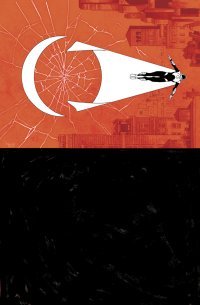 coming to the end of recent glut of new, rebranded and renumbered series, with two of the new incoming titles signalling a return from the creative team behind one of my favourite arcs of Astonishing X-Men: Warren Ellis and Kaare Andrews.
coming to the end of recent glut of new, rebranded and renumbered series, with two of the new incoming titles signalling a return from the creative team behind one of my favourite arcs of Astonishing X-Men: Warren Ellis and Kaare Andrews.
Yeah. That’s right. Warren Fuck-Mothering Ellis and Kaare Andrews.
Just not, you know, on the same book. But still! Warren Sodding Ellis! And he’s teaming up with artist Declan Shalvey, last seen doing a damn fine spot of Mike Mignola-ing on the Hellboy graphic novel The Midnight Circus. And they’re doing a series based on Moon Knight, the fifteenth-least-likely-to-be-a-bestseller character in Marvel history. And you know what? Two issues in, and I’m hooked.
This, ladies and germs, is what Warren Ellis does. He takes characters that don’t work, shouldn’t work, haven’t worked for years, or have otherwise become fossilised by the recursive feedback loop of fan expectations and publisher’s fear of losing their base, scrapes away the burnt-on grime and detritus and gets to their very core. And then he gives them much needed context. He’s not afraid of characters that look or sound ridiculous on paper; he just makes them own their eccentricities. This is the man who created Spider Jerusalem, made Iron Man relevant for the first time since the Seventies and created a team book featuring all the stuff that was too out there for the mid-2000s Civil War-obsessed Marvel reader. That Shalvey is doing the art is nothing but good news for both of them – it indicates in Marvel a confidence in both of their outputs and a continuing interest in developing their sideline of visually striking, pulp-influenced books.
Speaking of which…
Kaare Andrews. Film-maker. Cartoonist. Scourge of Autocorrect. And now, writer/artist of Iron Fist: The Living Weapon.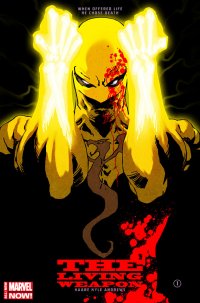
Hmmm…
This is making me think of Eighties Frank Miller, for what that’s worth. As a fan of the aforementioned Immortal Iron Fist, I’m not sure how necessary reworking Danny Rand aka Iron Fist as Grim ‘n’ Gritty Anti-Hero #Eleventy-Billion-and-One really is. As originally conceived, he was essentially Bruce Lee with literal flaming fists of fury (hence the name, I guess), and Immortal Iron Fist’s focus on ninja battles, interdimensional martial arts tournaments with Game of Death/Enter the Dragon-esque opponents and a reworked legacy backstory reflected that goofy but enticing simplicity and clarity of creative vision. Andrews’ version is still getting cooking, but it feels like it’s going to suffer a little from what a lot of writer-artist books suffer from – a lack of discourse between creators and editors that leads to artwork that is just a little bit too minimalist to get the point across and slightly worrying attitude towards female characters.
You know. Like Frank Miller.
I could be wrong, I could be right. We’ll find out soon.
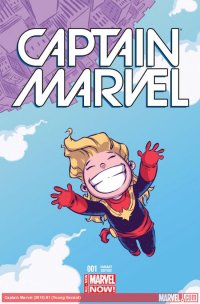 On the subject of female characters, here’s some that are getting the treatment they deserve. Two issues into its rebrand, Kelly Sue DeConnick’s run on Captain Marvel is on fire, and I’ll be highly annoyed if it ever gets cancelled. It won’t be for lack of sales – I’ve routinely ended up missing out on it due to most of my go-to places being out of stock. The current arc, “Higher, Further, Faster, More”, continues to have fun cameos from earth-bound Avengers and galactic Guardians alike, as well as exciting space action and witty banter galore.
On the subject of female characters, here’s some that are getting the treatment they deserve. Two issues into its rebrand, Kelly Sue DeConnick’s run on Captain Marvel is on fire, and I’ll be highly annoyed if it ever gets cancelled. It won’t be for lack of sales – I’ve routinely ended up missing out on it due to most of my go-to places being out of stock. The current arc, “Higher, Further, Faster, More”, continues to have fun cameos from earth-bound Avengers and galactic Guardians alike, as well as exciting space action and witty banter galore.
Likewise on good form is Dark Horse Comics’ stable of Whedonverse books. Serenity: Leaves on The Wind continues to be a worthy successor, with no end of fanservice for fans of the series, and Christos Gage and Rebekah Isaac’s upgrade to writer-artist team on Buffy Season 10 makes a surprisingly breezy job of re-establishing the status quo – admittedly for what feels like the half-dozenth time – and promising shininess to come.
Also, buy Dredd: Underbelly. Just because. Seriously. I want an actual sequel to the Karl Urban-starring, Alex Garland-scripted film sometime before I turn 30. And if you have any taste, so should you. I mean, Underbelly’s good anyway, but I want a sequel like five minutes ago. Also, go watch Dredd if you haven’t – it’s fried gold.
Greg Rucka and Michael Lark’s Lazarus, now eight issues in, is gathering pace, with the second arc, “Lift”, going into greater detail on Forever Carlyle’s backstory, setting up a growing threat in the form of a ragtag group of guerrillas called the Free, and building up a picture of life for a “serf” within the complex dystopian world of the series.
And finally, The Superior Spider-Man Finale Issue. Some of you will remember, lo those many moons ago, for my first review on here I  reviewed Superior Spidey #16 and #17 a few weeks later. Now, with #31, we’ve come to the end of the “Goblin Nation” arc. Peter Parker is back. Doc Ock is no more. Norman Osborn (now with a new face and ridiculous moustache) is defeated and everything gets wrapped up in a nice neat stick pile of OH WAIT NO, the other thing!
reviewed Superior Spidey #16 and #17 a few weeks later. Now, with #31, we’ve come to the end of the “Goblin Nation” arc. Peter Parker is back. Doc Ock is no more. Norman Osborn (now with a new face and ridiculous moustache) is defeated and everything gets wrapped up in a nice neat stick pile of OH WAIT NO, the other thing!
Let me reiterate what I said back in August: “I’ve never been much of a reader of Spider-Man comics. I never got involved in the bitchy back and forth over who was better out of Betty and Veronica or whatever their names are (note the sarcasm). I never liked the Venom/symbiote breakout characters, or the ridiculous plot-twists or the constant reworking of the character to fit whatever fad was happening at the time. And I goddamn hated the Amazing Spider-Man film, and everything I hear about the sequel makes me feel just that slightest bit more cynical and pessimistic about the whole thing.
“But I get it, guys – web-swinging is cool. When he’s good, Peter Parker is a great character to get to play with. He’s one of us – we share in his glories and foibles, his ecstatic victories and crushing defeats. Spider-Man has never not been a relevant character. Well, except when they tried to make him a clone or give him extra arms or put him in that ridiculous Iron Spider armour or wrote his marriage out of continuity in order for Aunt May – who by now has surely gone through enough – to keep puttering around.”
The thing that has characterised the writing of Superior Spidey series so far for me is a sense of being forcibly alienated from the character, firstly by him being taken over by Otto Octavius and turned into a completely egotistical sociopath, but more importantly by the fact that no-one in his direct circle of friends and acquaintances besides a two people I’d never heard of could figure out that he’s been body-snatched by a villain and has completely altered his personality and lifestyle. With the exception of two or three characters who are in the know, everyone within three degrees of Peter Parker is either an idiot or a terrible person. Except Aunt May, I guess.
What makes this issue stand miles above the previous issues I’ve reviewed, however, is the fact that Dan Slott is only getting a story credit while Christos Gage (whose stock is rising, in my book) takes over script duties for the concluding episode of “Goblin Nation” (meh) and in a surprising double whammy, the epilogue story “Actions Have Consequences”. This is where the Christos Gage magic happens and I get to see what a good writer can do with Spider-Man for the first time since I read Spider-Man: Blue: Peter Parker, knowing he is not to blame for what’s happened in his absence, but dealing with the fallout anyway, because with great power comes great responsibility. Sure, he’s still lying to Aunt May, and sure he doesn’t quite manage to save Mayor Jameson’s bacon***, but I feel like for the first time in ages he has dealt with a no-win situation like a man.
The kicker, though, is Mary Jane’s response. She’s the one who gets the truth. And she gives him some hard truths back. I’d just like to share with you the best dialogue scene I’ve ever read featuring this character in any format:-
“Peter. Stop. I believe you. I know things like this happen to you. And I understand it’s not your fault. It’s your life. But I can’t have it be my life anymore.
“One minute I’m being threatened by the Venom symbiote. The next, the Green Goblin’s men are trying to kill me. At some point, the “why” of it just doesn’t matter.
“You’ve made your choice about how to live. I understand it… even admire it. For a long time, I lived it too. But lately, I’ve been living on my terms. A great job. A great guy. Is it perfect? Of course not. But the problems are normal. I can handle them.
“Peter… I’m glad you’re back. I’m glad you’re okay. Really. But you and I both know there’ll be something else. And something else after that.
“I’ll always care for you. But I can’t have my life consumed by yours anymore. I… I won’t.”
That, ladies and gentlemen, is the sound of Mary Jane Watson dropping the mic. After being subjected to constant threat, a dull marriage, a mystical retcon, being played by Kirsten Dunst, almost being played by Shailene Woodley and the resulting misogyny from readers that those things bring, Mary Jane isn’t being defined by Spider-Man or Peter Parker anymore. Lois Lane could learn something from her, if she weren’t written for by a company that has the self-awareness and charisma of an undercooked potato.
Speaking of which, I’m thirty-two weeks into my year-long embargo on DC Comics. I’ve barely noticed what I’m missing out on anymore. Suggestions for things to read when I break my fast can be left in the comments.
So yeah. That’s your lot for the moment. I’ve not written off the possibility of actually doing a column a week just yet, but naturally, duty calls. Plus I’m beginning to think that there are people trying to communicate to me through my laptop. I suspect my girlfriend is an agent for a rival organisation. The monkeys want to steal my face. What? Who’s there? What are you doing with that garden trowel? Get away yoy swine! I’m a journalist, goddamn it! Help! They must be stopped!! Death to Videodrome! Long live the New Flesh!
*If anything, it’s more like Scott Pilgrim’s kinky sister. The figurative sister of the comic, that is – not the character Scott Pilgrim’s sister Stacey. That would be weird. #ContextisEverything.
**Which on reflection is probably why it only lasted 12 issues. #Nextwavefor2016.
*** The ending stinger with Jameson resigning Nixon-style after chewing Spidey out over him being an irresponsible sociopath without a hint of irony was a nice touch; his promise that he’d be kicking people around in future gave me flashbacks to the 1960s cartoon. #VoteJamesonFor2016.
The Eltingville Club #1 (of 2)(Dark Horse, $3.99)
by Graig Kent
When Evan Dorkin debu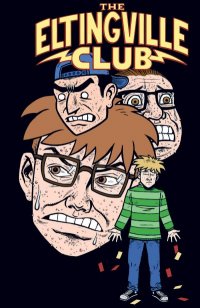 ted the Eltingville Club in the short-and-sadly-forgotten Instant Piano anthology over two decades ago, it would be the first of many scathing indictments of comic book fandom by way of four hateful characters and their toxic love for their hobbies. The Eltingville Club was born out of fan rage, that is to say, rage directed outwards at the fans, those marginalized geeks and nerds so unhappy in their lives and with the world around them that they escape into the worlds of fantasy, sci-fi, comic books, horror and role playing games, and yet still seem to find very little joy in that escape.
ted the Eltingville Club in the short-and-sadly-forgotten Instant Piano anthology over two decades ago, it would be the first of many scathing indictments of comic book fandom by way of four hateful characters and their toxic love for their hobbies. The Eltingville Club was born out of fan rage, that is to say, rage directed outwards at the fans, those marginalized geeks and nerds so unhappy in their lives and with the world around them that they escape into the worlds of fantasy, sci-fi, comic books, horror and role playing games, and yet still seem to find very little joy in that escape.
The Eltingville Club was born back when San Diego Comic Con was still a Comic Con, before the internet went large, a short while before South Park, and long before the Big Bang Theory and other dedicated pop-culture efforts made nerds and nerd stuff socially acceptable. It was, for a time, well ahead of its time. At one point, The Eltingville Club was primed to break out with an animated pilot in the early years of Adult Swim’s programming, but despite a network and an audience warming to bitter, nerd-based humour, it wasn’t to be.
This is the first comic-length Eltingville Club story, and the question that first entered my mind was whether the Club and their bepimpled denizens would maintain the same level of satire they once had, whether Dorkin would find a way to keep the characters recognizable but still address the ugly truth of today’s extreme fandom.
The result is somewhere in the middle, where it feels like Dorkin’s striving to reach for more modern criticisms of geek culture, but he frequently devolves into variations of geek cliches. The book centers around the fact that Bill gets a job at the local nerd den, Joe’s Fantasy World. The Joe of Joe’s Fantasy World is every horrible retailer trait rolled into one obese, monobrowed package: rude, sexist, belligerent, ignorant and with terrible business sense, surviving by keeping a stranglehold on his customer base by treating them like junkies, ensuring his clientele doesn’t contract, but equally ensuring that it doesn’t grow. Dorkin beats home the fact than many nerd dens are ugly, messy, unforgiving and unwelcoming places, but it’s also the stereotype and it’s kind of disappointing that Dorkin chooses to perpetuate it, beating all the usual (and a few unusual) stereotype drums that go along with it. It would have been far more interesting to put the guileful Bill in a more modern shop and watch the world crush him, but even in this situation, in an environment that should be his own terrain, it still implodes around him.
The world of Eltingville is the world at its ugliest and finding the dankest of spaces to put them in is the point. These are outsiders that have come to embrace being such. The whole point of their Club is to exclude others, not welcome those like of mind. Dorkin doesn’t really spend much time examining what makes these rage bombs tick, instead focusing more on setting them off, which seems altogether too easy. But to read The Eltingville Club is to watch the struggle for dominance amidst the weakest of individuals: the constant put-downs, the incessant arguing, the petulance and rage all devolving into (most surprisingly) physical violence, fragile egos shattering and sad souls looking for acceptance, or, barring that, a feeling of superiority.
Dorkin’s style for the characters, their wardrobe and the atmosphere they hang out in, hasn’t changed much since their debut, but then Dorkin’s style is much the same as it always has been. Thick black lines, a hyperactive amount of detail, and a certain dinginess thanks to the crosshatching make Eltingville an unpleasant place populated with unpleasant people, but it’s perfect at the same time. The cast still feel like grungy 90’s dorks in Dorkin’s style, having pretty much the same arguments and conflicts that nerds have had for the past 30 years. But there’s truth in that sameness, that the gathering of truly unhappy people results in encounters that leave no one happy and little changes. Like the South Park gang, there’s very little friendship to be found in their shared experiences, and their anti-adventures typically devolve into a full-out, geek-stuff-destroying brawl. These individuals shouldn’t be friends, and the reality is they aren’t, but their only alternative is being alone.
This issue of The Eltingville Club is funny, but more funny-sad than funny-ha-ha. Also the opening half, centered around Bill in his new job, has its moments, but is largely a rehash of familiar comic shop culture criticisms for anyone paying attention to comic culture in the past 10 years, as if putting them all in one place for posterity. The book doesn’t really get going until the gang all gets together and their tumultuous dynamic takes over. Though the characters over the years have aged slightly I was mpre hoping this mini-series would take them 20 years after their first appearance, to see how they had grown or changed with (or without) the culture they grew up supposedly loving. But as it stands any Dorkin is better than no Dorkin.
Rating: 




Out of a Possible 5 Stars
Xenolglyphs #1 (OSSM, $0.99)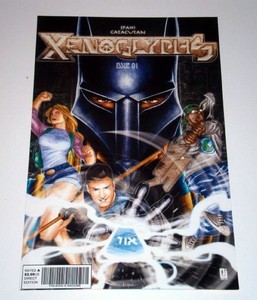
By Cat Taylor
Whenever possible I like to make room for at least one review of an independent digital comic. I figure that the mainstream titles already get plenty of exposure. However, with all of the titles in internet-land, it’s difficult to ascertain which ones are worth recommending and which aren’t. So, I have to rely on the advertised plot summary and then take chances on a few until I find one worth writing about. Unfortunately, none of the independent underground titles I read really impressed me this week. Since nothing stood out, I decided to review Xenoglyphs mainly because it’s a new series and because the premise at least intrigued me.
Xenoglyphs involves a quest to collect all nine of the stones known as the Xenoglyphs. These stones allow the wielder to possess god-like power and have been used throughout history by mythologized figures such as Zeus, Poseidon, etc., which led to their status as the ancient gods of Greece. At this point in the story, there is no explanation as to how the former gods lost their Xenoglyphs, but the few people in the know are aware that they are hidden separately in prominent monuments around the world. Nobody knows which ones exactly, but they can at least narrow the field down to well-known structures such as Easter Island, the Pyramids, Mt. Rushmore, and places like that. There are several groups, known as Separators, searching for the Xenoglyphs, and at least one other group that is EEEVVVIlLLL!!!! (I put the emphasis there, because it’s that kind of story.). Furthermore, anyone who collects all nine Xenoglyphs will have virtually unlimited power, BUT he/she has to create nine more Xenoglyphs. It’s a lot of information to cram into a first issue, and because the writer decided to do it that way, this issue contains more exposition than actual story.
My synopsis is more detailed than the advertised plot summary of this issue. With the additional information provided above, I am willing to bet that many long-term comic readers can see several immediate problems. One obvious problem is why would it take this long for the Xenoglyphs to be recovered if several Illuminati types already have the locations somewhat narrowed down? In fact, I’ll go ahead and reveal that one of the Xenoglyphs is recovered incredibly easily in this issue, which only further begs the question. Another problem is that I’m probably not the only one who thinks they’ve seen all of this before in Infinity Gauntlet, Rex Mundi, DaVinci Code, and National Treasure just to name a few of the more obvious stories. Sadly, nothing in this story, written by Omar Spahi, does anything to improve upon those concepts or add any originality.
As far as the artwork is concerned, PJ Catacuhan does a sufficient job of bringing the story to life and creating recognizable characters and environments. Catacuhan has an identifiable style that is certainly better than average, largely due to his/her work with color. I can’t tell what medium Catacuhan is using to color his/her work but it definitely adds to the quality. In fact, considering that the art looks somewhat flat and the characters appear stiff even when involved in action scenes, it probably wouldn’t look nearly as good if it were in black and white.
Overall, Xenoglyphs comes off like the brainchild of creators who are barely out of high school publishing their first serious comic. They seem to have absorbed ideas from various sources and feel like they have an original and exciting plot, but due to lack of writing experience and possibly a lack of awareness of how clichéd many of these ideas really are, the first issue is fairly underwhelming. However, everyone has to start somewhere. Hopefully, experience will be a great teacher.
Rating: 




Out of a Possible 5 Stars
ELEKTRA #1 (Marvel Comics, $3.99)
By Devon Sanders
In the opening page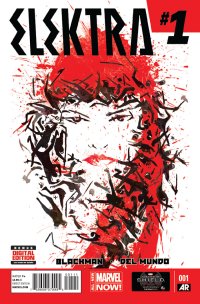 s of Elektra #1, writer W. Haden Blackman describes her as all of the following: daughter, lover, assassin, victim, someone’s heartbreak and finally, without quite saying it, unchallenged.
s of Elektra #1, writer W. Haden Blackman describes her as all of the following: daughter, lover, assassin, victim, someone’s heartbreak and finally, without quite saying it, unchallenged.
In this first issue, Elektra takes on potentially her biggest threat; an assassin so lethal, so out of control, the likes of Sabretooth, Bullseye and Taskmaster, combined, couldn’t fulfill the contract.
The contract is reopened and Elektra sets off to find an assassin who cannot be killed. With an air drop into a place only a killer would run towards, Elektra is set on an encounter that can only end in blood and death.
Blackman smartly addresses Elektra’s past as something that should be embraced but not relived over and over again. In Blackman’s hands, it’s used as more of a springboard to the new. Old threats are introduced in new contexts, giving new readers and old reasons for excitement. With tight dialogue, Blackman gets the reader into the mindset of the ultimate antagonism and I can’t wait to see where he takes it.
Illustrating it all beautifully is series artist Mike del Mundo. There is a grace on these pages that suggests ballet and flow. Del Mundo beautifully crafts every page to fit the needs of the script, delivering some of the most thoughtful art I’ve seen on a comics page.
With its promise of death, S.H.I.E.L.D involvement, an intriguing new villain and more, Elektra #1 is definitely a book I’m very much excited about.
Rating: 




Out of a Possible 5 Stars
Superior Spider-Man Team-Up #12 (Marvel, $3.99)
By Cat Taylor
You could say that my timing for reading my first issue of any Superior Spider-Man series couldn’t be worse. I waited for this final issue of 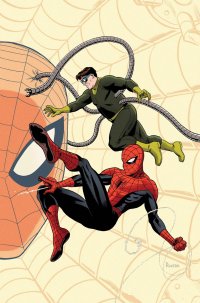 Superior Spider-Man Team-Up to be my introduction to the series. Don’t get me wrong, I know basically what’s been going on. I know that Dr. Octopus was dying and he was able to switch minds with Peter Parker right before he passed away, making him the new inhabitant of Spider-Man’s body. I know that somehow, Peter Parker’s mind didn’t actually, or fully, transfer and that his persona was still buried inside his body’s brain, setting up for his inevitable return. I also know that Dr. Octopus as Spider-Man decided not to be a villain but to try to be a better Spider-Man than Peter Parker ever was and therefore was using his scientific knowledge to create new weapons and techniques that Parker never used. Finally, I know that the Dr. Octopus personality made the “Superior Spider-Man” more of an anti-hero and pretty much an asshole.
Superior Spider-Man Team-Up to be my introduction to the series. Don’t get me wrong, I know basically what’s been going on. I know that Dr. Octopus was dying and he was able to switch minds with Peter Parker right before he passed away, making him the new inhabitant of Spider-Man’s body. I know that somehow, Peter Parker’s mind didn’t actually, or fully, transfer and that his persona was still buried inside his body’s brain, setting up for his inevitable return. I also know that Dr. Octopus as Spider-Man decided not to be a villain but to try to be a better Spider-Man than Peter Parker ever was and therefore was using his scientific knowledge to create new weapons and techniques that Parker never used. Finally, I know that the Dr. Octopus personality made the “Superior Spider-Man” more of an anti-hero and pretty much an asshole.
While I found the Superior Spider-Man concept somewhat interesting, I found it more of an insult to my intelligence and a blatant marketing ploy that would obviously be undone as soon as the novelty wore off. With an opinion like that, why did I pick up the final issue? Mainly because the cover depicted Spider-Man teaming up with Dr. Octopus, and I wanted to see what the heck was going on. Doc Ock should be dead, or at least that young body of his should. So, with nothing else to read this week, I figured I’d give it a shot and if they got me, then they got me.
Fortunately, this issue exceeded my expectations. The cover image is a cheat since Spider-Man and Dr. Octopus don’t physically team up. The “team up” is supposedly the shared mind between Parker and Ock, but even that only comes into play in the last two panels of the book. The meat of this story is a flashback to a story told in Spider-Man Unlimited #3, which I’m pretty sure was one of those “untold” stories from earlier in Spider-Man’s career when Dr. Octopus and the Green Goblin teamed up to try and defeat Spider-Man. In this issue of Superior Spider-Man Team-Up, Octopus is recalling that ill-fated team-up with the Goblin and how it fell apart due to Goblin killing “the only woman Octopus ever loved” in an attempt to get Octopus to stop being so science-minded and to let out his maniacal side. One thing led to another and an intense rivalry developed between Octopus and Goblin, with Octopus trying to prove he was superior and that science was always the answer in everything from finding a cure for his dying former lover, to defeating Spider-Man, to beating the Goblin. Many of the layers of this “competition” and the differences between Dr. Octopus and the Green Goblin are overt and many are only suggested. As I read the story, I started analyzing all sorts of statements the characters made and drew many of my own conclusions and parallels. I probably read way too much into the story but the fact that the story was set up in a way that allowed me to do that made me enjoy it all that much more. On one level, a reader can enjoy this story for what it obviously is, but on another level you can use your own pseudo-intellectualism and play armchair psychologist or amateur philosopher and really start unraveling the characters and what the writer, Kevin Shinick may be trying to say.
Since most of this story is a flashback to the period of Spider-Man comics that were published in the 1970s, or possibly early 80s, the pencils were done by Ron Frenz and the inks by Sal Buscema, two of the prominent Marvel artists during that time period. They captured the Marvel house-style from that era like they never left it. The three pages that take place “today” were drawn by Marco Chechetto, and those pages have a more modern look that would comfortably fit in the old Marvel magazines or any of the current graphic novels.
Overall, this is a worthy send-off to whatever the series became during the “Superior” run. It’s a high quality story on its own, but it’s also a story about second chances, including the second chance at life and redemption that Dr. Octopus had, and the second chance at life that Peter Parker is getting. It’s also letting Dr. Octopus go with some credibility. He isn’t just a villain that Spider-Man finally defeated. Ultimately, Dr. Octopus won a lot in his own way and his life ended with dignity and some amount of respect that he never received as the portly metal-tentacled Spider-foe with the Moe Howard haircut. It’s funny that so few of the better-known titles have had finales that felt worthy, yet this second tier Spider-Man title has a final issue that does everything that a grand finale/intro to a new series should.
Rating: 




Out of a Possible 5 Stars